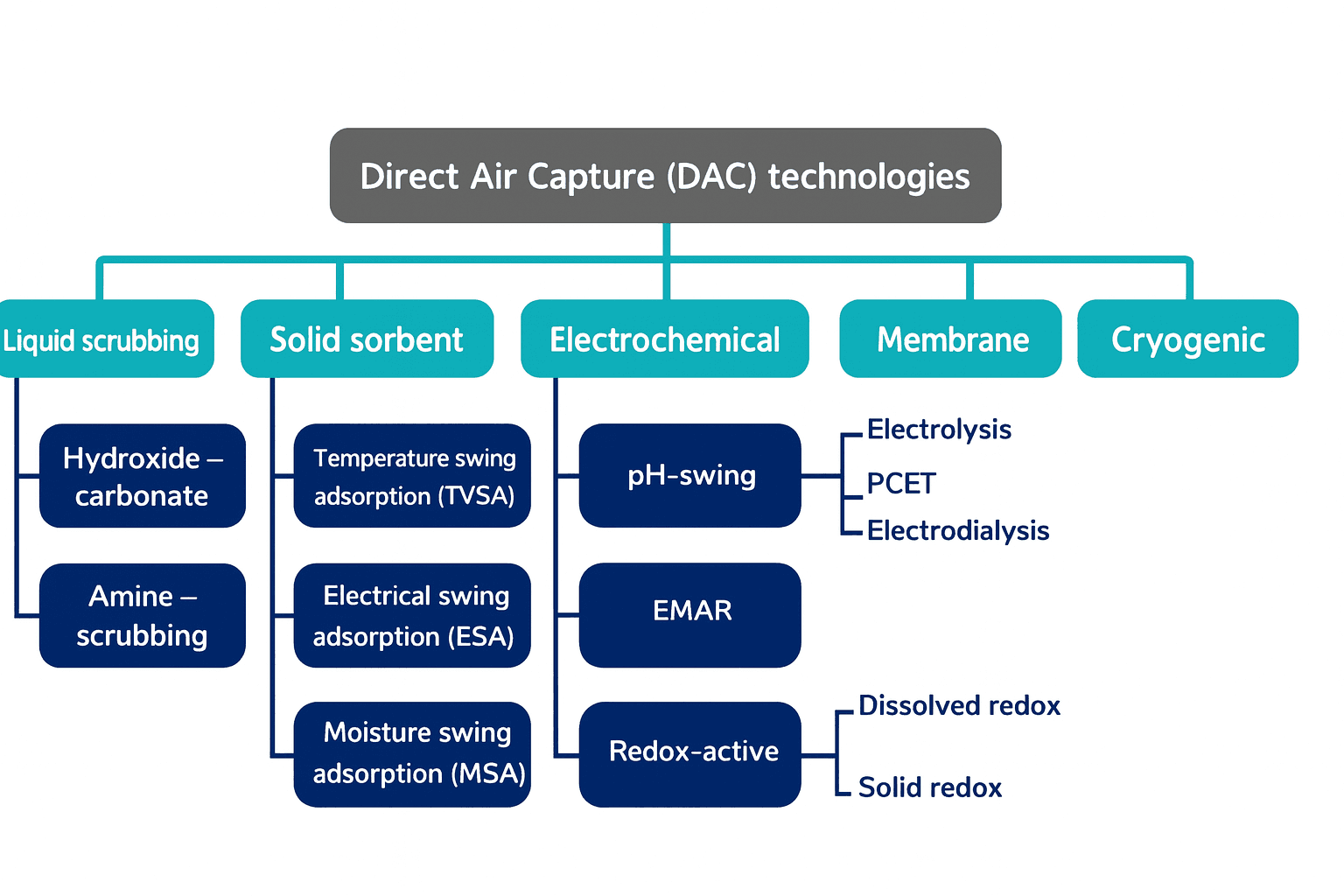DAC Technologies: The Potential and the Challenges
Direct Air Capture (DAC) technologies are emerging as powerful tools to reduce atmospheric carbon dioxide (CO2) levels as our global community rallies to combat the unavoidable issue of climate change.
While DAC technologies hold immense promise, industry and governments face the formidable challenge of taking these technologies to the grand stage, where they can make a worldwide impact.
The Different DAC Technologies
This table compares the main DAC technologies – each approach is suited to different contexts based on resource availability, scalability, and energy intensity.
NEG8 Carbon develops solid sorbent based DAC technology and has moved the needle in DAC technology with a number of innovations that reduce costs and speed up the carbon dioxide capture process.
To find out more, have a look at What is Direct Air Capture and How Direct Air Capture Works.
| DAC Technology | Method | Capture Material | Capture Efficiency | Advantages | Challenges |
|---|---|---|---|---|---|
| Solid Sorbent-based DAC | Adsorption of CO2 on solid materials | Solid sorbents (e.g. amines, zeolites) | High (~70–90%) |
Reusable sorbent materials, lower water usage | Regeneration of sorbent requires energy |
| Liquid Solvent-based DAC | CO2 absorbed into a liquid solution, forming a chemical bond | Alkaline solutions (e.g. potassium hydroxide) | High (~85–90%) |
Highly scalable, effective at high CO2 levels | High water usage, solvent regeneration |
| Metal-Organic Framework (MOF) | Adsorption using highly porous structures | Metal-organic frameworks | Very high (>90%) |
Ultra-high surface area, strong CO2 binding | Expensive materials, complex synthesis |
| Electrochemical DAC | CO2 captured using electrochemical reactions | Liquid sorbents + electrodes | Moderate (~70–80%) |
Lower thermal energy requirement | Requires significant electrical energy |
| Membrane-based DAC | Selective CO2 separation through membrane materials | Specialised membrane polymers | Variable (~50–90%) |
Can operate at lower temperatures | Membrane fouling, high maintenance |
| Cryogenic DAC | CO2 separated by cooling air to very low temperatures | None (uses phase change) | Very high (>90%) |
No chemicals or sorbents needed | Extremely energy-intensive cooling |
| Direct Mineralisation DAC | CO2 reacts with minerals to form stable carbonates | Natural minerals (e.g. olivine, basalt) | High (>80%) |
Produces long-term carbon storage | Requires large quantities of minerals |
Image source: Chemical Engineering Journal 484 (2024)
Potential of DAC Technologies at Scale
For carbon dioxide removal technologies like DAC to gain ground, those in positions of authority and influence need to see the urgency of the climate crisis we face. And DAC has a role to play; learn more about why Direct Air Capture.
Infrastructure Development
To bring DAC technology to the fore, businesses and governments must invest in carbon capture development and infrastructure. This entails establishing large-scale DAC facilities equipped with proven capture systems. While the initial capital investment may be substantial, the long-term rewards in terms of carbon reduction and corporate sustainability can far outweigh the costs.
Economic Incentives and Policy Support
The central role of governments and regulatory bodies in driving the widespread adoption of DAC cannot be understated. Businesses can unlock the true potential of DAC by leveraging economic incentives and policy support, such as tax credits and subsidies, to offset the initial financial barriers. Collaborative efforts between the public and private sectors can lay the foundation for a conducive environment, facilitating the scalability of DAC technologies.
For more, see: Is Direct Air Capture Viable?
Challenges DAC Technology Faces
Energy Requirements
DAC technologies are energy-intensive and so should rely on renewable energy sources for sustainability and preferably off-grid renewable energy sources. Scaling up brings new challenges in meeting increased energy demands, underscoring the urgency of advancements in renewable energy technologies to bolster the expansion of DAC systems.
Carbon Capture Efficiency
Improving the efficiency of carbon capture processes is an essential step towards maximum scalability. Enterprises like NEG8 Carbon are dedicating resources to research and development, striving to enhance the effectiveness of DAC technologies. The goal is to continuously innovate to capture and permanently remove CO2 more efficiently to make DAC technology affordable enough for mass deployment.
The Cost Equation: Cost Reduction
Cost remains a formidable barrier to the widespread implementation of DAC technologies. However, continuous innovation and dedicated research efforts are driving costs down, making DAC a more economically viable choice for broad-scale adoption. Advances in sorbents, energy usage and the process itself are seeing DAC costs edge towards the $150 per tonne CO2 captured that is the benchmark DAC developers are aiming for.
See: Direct Air Capture Cost Compared to Cost of Inaction on Climate Change
Safety Concerns Regarding CO2 Transport and Storage
An advantage that Direct Air Capture has over point source carbon capture is that it is location flexible. A DAC plant can be located anywhere and does not need to be at the source of emissions such as a power station. This means it can be located at the site of CO2 storage and/or utilization and does not need to be piped long distances through urban areas. The CO2 that DAC captures can be mineralised deep underground where it is permanently and safely stored without the possibility of leaks.
Gaining Public Trust
Widespread adoption of DAC may encounter resistance due to concerns regarding the environmental impact of large-scale infrastructure and the potential side effects. Transparent communication and active engagement are indispensable to address these concerns and foster public acceptance.
In Conclusion: DAC Technologies Contributing to a Sustainable Future
The scalability of DAC technologies holds promise for businesses committed to reducing their carbon footprint and contributing to global sustainability goals. Challenges exist, but proactive endeavors in infrastructure development, integration with existing processes, and fruitful collaborations with governments can light the path toward the universal adoption of DAC.
For more:
- Hard to Abate Industries and the Decarbonization Challenge
- What is CO2 Utilization?
- Carbon Capture Methods Compared: Forestation vs Direct Air Capture
- Solid Sorbent DAC Compared with Electrochemical DAC


